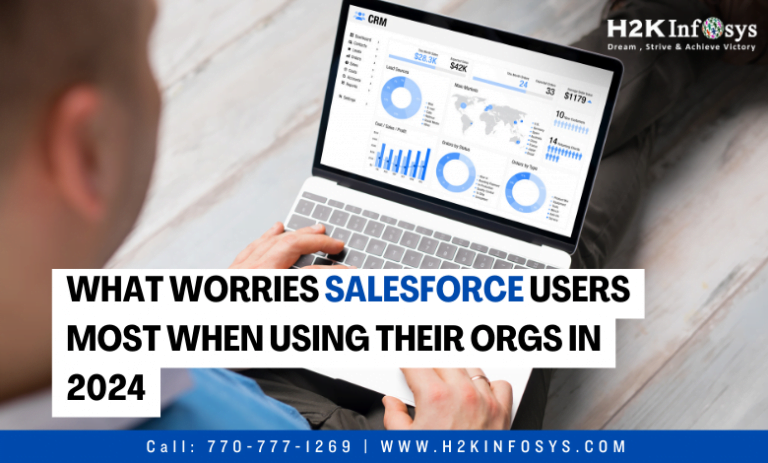Salesforce is a powerful platform that can be used to digitise business operations and automate internal processes. But occasionally, problems occur when using the platform. Here are some things that might worry Salesforce users in 2024. Check out the Salesforce admin certificate training to learn more.
1.Apex Governor Limits
The concept of governor limits is used in a multi-tenant setting to prevent monopolisation of Salesforce’s shared resources. If you go beyond these restrictions, Apex code won’t function, so you should consider reviewing it. Here, there are two significant issues.
CPU Time Limit Exceeded occurs as a result of automations taking too long, such as Apex, Flow, etc. For such circumstances, the following are some best practices:
- Steer clear of intricate calculations: Complex logic might use a lot of CPU power. Use straightforward functions and make your code as simple as possible. If you need to perform computations that use a lot of resources, think about utilising Salesforce Functions or creating a Heroku app.
- Review how loops are used: Loops take up a large amount of CPU time, particularly nested loops. To avoid going through documents one by one, think about employing bulk processes or collections.
- Steer clear of recursion: It can easily push you over the CPU time limit. Take care not to repeat yourself indefinitely.
- Asynchronous processing: You can carry out resource-intensive or time-consuming operations in the background without affecting the ongoing transaction by using the queueable/future and batch Apex methods.
- Bulkify code: Write code that can effectively handle massive volumes of data whenever at all practicable. Instead of writing code that processes one record at a time, use bulk patterns to process data.
When too much data is kept in memory when running Apex code, a Heap Size Limit is reached. Here are some recommendations for you:
- Make use of effective data structures: Select the appropriate data structures based on your needs.
- Reduce the amount of variables created: Don’t make any extraneous objects or variables. When a variable is no longer required, declare it with the smallest scope available and remove it.
- Restrict the size of the collections: Steer clear of big collections inside loops, such as Lists or Maps, as these can significantly increase heap size.
- Get rid of unnecessary resources: When you are done using resources, release them. Clear collections, for instance.
- Think about processing that happens asynchronously: Use asynchronous processing techniques, such as queueable Apex, for lengthy tasks.
Please feel free to check out more Salesforce best practices to assist you write code that adheres to the predetermined execution limitations.
So, it would be advisable to utilise a different API that stores your request or use bulk APIs if you are unable to access data in your organisation through a third-party app connection.
For instance, you may be utilising a series of successive requests to establish an opportunity, contact, or account from a third-party application, like a public website. This is a lot (three API calls) that you are using. Alternatively, you might minimise your API calls by using sObject Tree REST or Composite resources. In this instance, the request as a whole only counts as one call against your API limit.
Additionally, your application may be generating dozens or even hundreds of thousands of data entries every hour or day, indicating that real-time or near-real-time integration is being used. In this situation, one may wonder if having all of these integrations happen in real time or almost real time is necessary. Making data replication a scheduled process, instead of something that happens every 15 minutes, hourly, or even daily, can save a significant amount of API calls. You can prevent your API call quota from exceeding by using Bulk API in this manner.
Salesforce offers recommendations for best practices while utilising specific APIs.
2.Storage Limits
When an organisation grows and the amount of business operations increases, Salesforce encourages users to scale up. The amount of time required to do specific tasks grows along with the volume of data that needs to be stored. It lengthens the time needed to do specific tasks. File storage and data storage are the two categories into which Salesforce storage is separated. They both require optimization.
To make working with files as efficient as possible, carefully arrange them in folders, collaborate on files using version control (rather than duplicating files), and go over outdated files and files belonging to inactive users. Additionally, there are several recommended procedures for handling large data volumes (LDVs). These include adopting more effective techniques to load LDVs into Salesforce, utilising mashups and selective searches, and archiving superfluous data. The best practices for LDV deployments can also be viewed.
3.Bugs caused by Customization
Custom software invariably contains problems since it is impossible to anticipate every scenario and account for every dependency. You can, nevertheless, adhere to the following guidelines to reduce the quantity of bugs and their effects:
- Utilise Git for branching, source control, and developing a release plan.
- Utilise SFDX and source-driven development
- Put into effect recommended practices for development and coding, such as unit testing for both Apex and LWC code.
- Put into practice an effective environment plan for Salesforce operations and development.
- Establish development sandboxes, QA environments, UAT environments, and hotfix orgs.
- Implement static code analysis and peer code review into practice.
- Implement automated regression testing into practice.
- Train QAs the ins and outs of Salesforce (getting admin certs is usually a big assistance.)
- Release more often and with higher granularity (CI/CD)
- Before releasing anything, test it for smoke and sanity.
- Underutilised aspects of the subscription
Salesforce customers occasionally buy licences for things they never use. They don’t know how to use the products or take advantage of specific features, or they don’t think they need them.
To begin addressing wasted licences and underutilised product capabilities, first review the summary data on the company information page in the setup menu. After that, you most likely require the assistance of a skilled Salesforce administrator to maximise your toolkit.
Compare your implementation, for instance, to the following useful features:
- Account, Opportunity, Case Teams
- Lead, Opportunity Scoring
- Prediction Builder & Next Best Action
- Einstein Bots
- Knowledge Articles Recommendations
- Email Integration
- Omni-Channel Routing
- Chatter
- Field History Tracking
- Forecasting
- Dynamic Forms
- Permission Set Groups
- Restriction Rules
- In-App Guidance
- Pipeline Inspection
- Scoping Rules
- DevOps Center
- DevHub & Scratch Orgs
- Flow Orchestrator
Conclusion
To learn more, you can check out the Salesforce certificate course online.


























